Taxonomy: Class: Mammalia; Order: Rodentia; Family: Sciuridae
Description
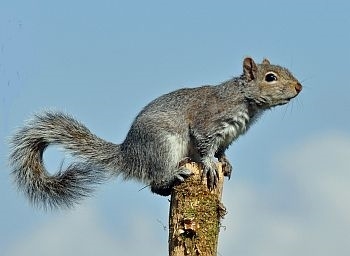
Grey squirrel © Peter Thompson
The grey squirrel is a rodent native to the eastern half of North America. This species lacks the prominent ear tufts of the indigenous red squirrel. It was introduced to many sites across Britain between 1876 and 1929, and spread rapidly. It has displaced the red squirrel through better exploitation of deciduous woodland (Gurnell 1987) and infection by squirrelpox, a disease fatal to reds but not to greys. At high densities, the grey squirrel can cause considerable damage to forestry, crops and gardens (Sheail 1999). It may be culled all year round.
Further information:
Mammal Society website grey squirrel page.
Conservation status and legislation
Status:
UK: Non-native
World: Least Concern (IUCN Red List)
Legislation:
Distribution and abundance
The grey squirrel is widely distributed across England and Wales. It has colonised the southern half of Scotland (including,Arran and Bute), and has been recorded in scattered locations further north. It occupies most of the eastern half of Ireland, although a scarcity of records means that this is not apparent from the map.
Estimates of grey squirrel abundance (numbers of individuals in the spring) across the UK, from Harris et al. (1995):
Recent trends from the National Gamebag Census
United Kingdom
Index of bag density from 1961 to 2009 (see statistical methods and interpretational considerations).
Error bars represent 95% confidence intervals.
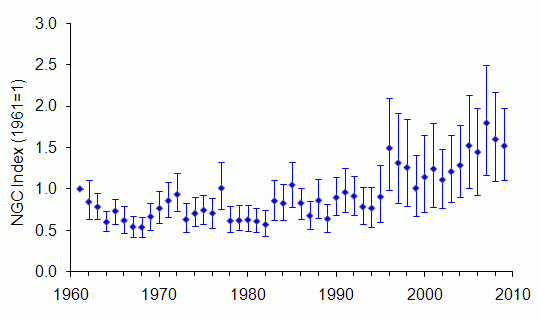
The bag index remained relatively stable until the mid-1990s, then increased steadily thereafter. This resulted in an overall significant doubling of the index between 1961 and 2009. This reflects the ongoing range expansion and increasing abundance of this introduced species.
Change in grey squirrel bags over time, with 95% confidence limits (see statistical methods):
| Country |
Sites |
Start
year |
End
year |
Change (%)
1961-2009 |
Change (%)
1984-2009 |
Change (%)
1995-2009 |
| United Kingdom |
983 |
1961 |
2009 |
97*
44 to 160 |
113*
73 to 161 |
59*
44 to 79 |
* significant at P < 0.05
England
Index of bag density from 1961 to 2009 (see statistical methods and interpretational considerations).
Error bars represent 95% confidence intervals.
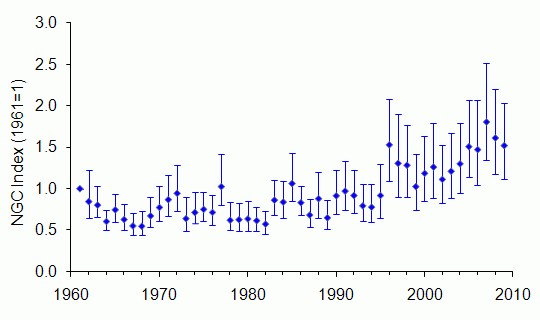
The bag index remained relatively stable until the mid-1990s, then increased steadily thereafter. This resulted in an overall significant doubling of the index between 1961 and 2009. This reflects the ongoing range expansion and increasing abundance of this introduced species.
Change in grey squirrel bags over time, with 95% confidence limits (see statistical methods):
| Country |
Sites |
Start
year |
End
year |
Change (%)
1961-2009 |
Change (%)
1984-2009 |
Change (%)
1995-2009 |
| England |
839 |
1961 |
2009 |
97*
54 to 160 |
112*
73 to 156 |
58*
39 to 77 |
* significant at P < 0.05
Scotland
Index of bag density from 1977 to 2009 (see statistical methods and interpretational considerations).
Error bars represent 95% confidence intervals.
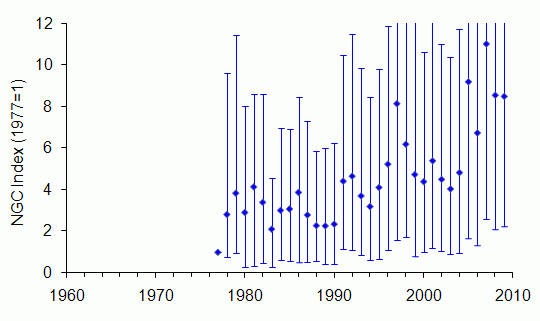
Between 1961 and 1976, there were just nine reports of bags from six sites. Since 1977, there has been a significant threefold increase in the bag index. This reflects the ongoing range expansion and increasing abundance of this introduced species.
Change in grey squirrel bags over time, with 95% confidence limits (see statistical methods):
| Country |
Sites |
Start
year |
End
year |
Change (%)
1961-2009 |
Change (%)
1984-2009 |
Change (%)
1995-2009 |
| Scotland |
98 |
1977 |
2009 |
311*
76 to 784 |
205*
142 to 369 |
100*
58 to 171 |
* significant at P < 0.05
Wales
Index of bag density from 1961 to 2009 (see statistical methods and interpretational considerations).
Error bars represent 95% confidence intervals.
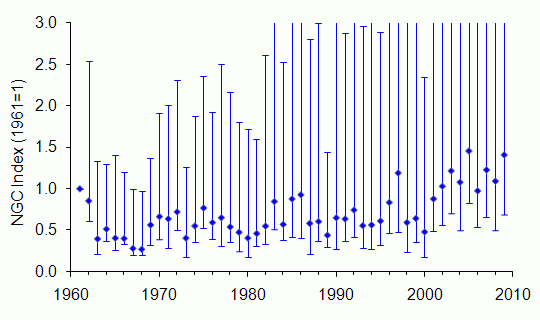
Although the bag index dropped initially, it has since built up steadily, with a significant increase between 1995 and 2009. This reflects the ongoing range expansion and increasing abundance of this introduced species.
Change in grey squirrel bags over time, with 95% confidence limits (see statistical methods):
| Country |
Sites |
Start
year |
End
year |
Change (%)
1961-2009 |
Change (%)
1984-2009 |
Change (%)
1995-2009 |
| Wales |
35 |
1961 |
2009 |
87
-12 to 711 |
107
-20 to 248 |
88*
13 to 182 |
* significant at P < 0.05
N Ireland
There are too few bag records of grey squirrel to produce an index graph. 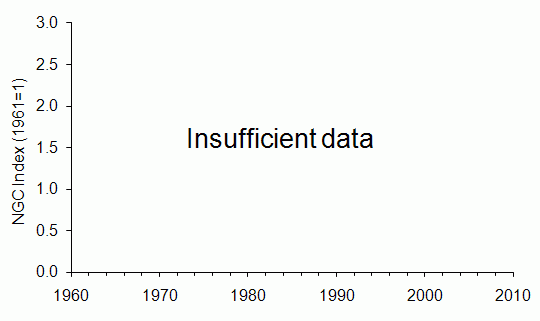
There are too few bag records of grey squirrel to evaluate rates of change over time
| Country |
Sites |
Start
year |
End
year |
Change (%)
1961-2009 |
Change (%)
1984-2009 |
Change (%)
1995-2009 |
| N Ireland |
Too few sites |
Environmental zones
Change in grey squirrel bags over time, with 95% confidence limits (see statistical methods):
| Environmental zone |
Sites |
Start
year |
End
year |
Change (%)
1961-2009 |
Change (%)
1984-2009 |
Change (%)
1995-2009 |
| Easterly lowlands (England/Wales) |
539 |
1961 |
2009 |
88*
34 to 157 |
113*
63 to 167 |
54*
36 to 76 |
| Westerly lowlands (England/Wales) |
234 |
1961 |
2009 |
112*
46 to 196 |
94*
60 to 149 |
59*
22 to 113 |
| Uplands (England/Wales) |
100 |
1961 |
2009 |
184
-41 to 449 |
139*
87 to 222 |
109*
48 to 178 |
| Lowlands (Scotland) |
50 |
1977 |
2009 |
311*
79 to 1015 |
219*
110 to 480 |
137*
72 to 305 |
| Intermediate uplands/islands (Scotland) |
21 |
1995 |
2009 |
no data |
no data |
35
-16 to 72 |
| True uplands (Scotland) |
30 |
1984 |
2009 |
no data |
281*
113 to 598 |
87*
4 to 187 |
* significant at P < 0.05
Comparison with BBS mammal data
Since 1995, data on grey squirrel abundance have been collected under the Breeding Bird Survey (BBS) organised by the British Trust for Ornithology. Below, the UK trend from the NGC is compared to the one from the BBS (from 1995 onwards).
NGC index of bag density (blue) and BBS index of abundance (red), from 1995 to 2009.
Error bars represent 95% confidence intervals.
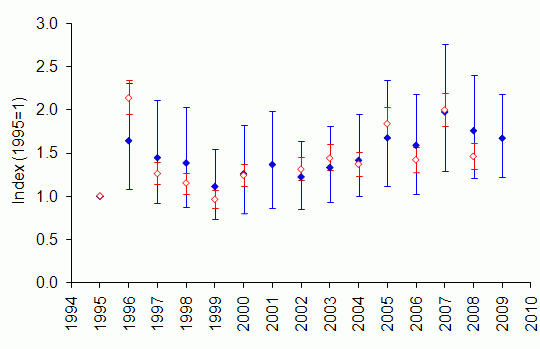
For all years, the BBS confidence intervals are completely or almost completely within the NGC confidence intervals, indicating good agreement between the two index series.
Long-term trend from the National Gamebag Census
There are too few bag records of grey squirrel to produce a trend starting before 1961.
References and further reading
- Battersby,J. (2005). UK Mammals: Species Status and Population Trends. Joint Nature Conservation Committee/Tracking Mammals Partnership, Peterborough (JNCC download page).
- Gurnell,J. (1987). The Natural History of Squirrels. Christopher Helm, London.
- Harris,S., Morris,P., Wray,S. & Yalden,D.W. (1995). A Review of British Mammals: Population Estimates and Conservation Status of British Mammals Other than Cetaceans. Joint Nature Conservation Committee, Peterborough (JNCC download page).
- Harris,S. & Yalden,D.W. (2008). Mammals of the British Isles: Handbook, 4th edition. Mammal Society, Southampton.
- Sheail,J. (1999). The grey squirrel (Sciurus carolinensis) - a UK historical perspective on a vertebrate pest species. Journal of Environmental Management 55: 145-156.
- Tompkins,D.M., Sainsbury,A.W., Nettleton,P., Buxton,D. & Gurnell,J. (2002). Parapoxvirus causes a deleterious disease in red suirrels associated with UK population declines. Proceedings of the Royal Society of London, Series B 269: 529-533.
This report should be cited as: Aebischer,N.J., Davey,P.D. & Kingdon,N.G. (2011). National Gamebag Census: Mammal Trends to 2009. Game & Wildlife Conservation Trust, Fordingbridge (http://www.gwct.org.uk/ngcmammals).
Return to species list